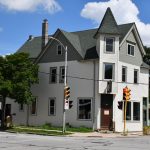Surge in Milwaukee Gun Shootings Challenges Anti-Violence Efforts
414LIFE team of workers has hit the streets hard in recent weeks.

Members of 414LIFE distribute information during a community popup on the North Side. (Photo by Edgar Mendez/NNS)
As they hit the streets, members of 414LIFE, a community and hospital-based violence intervention program, know their efforts could literally mean the difference between life and death.
That theory was put to the test recently when 414LIFE members showed up to diffuse a neighborhood dispute that also involved law enforcement officers on the North Side. If not for that intervention, Lynn Lewis, executive director of 414LIFE, believes the incident could have ended in tragedy.
“Frontline workers go into situations where emotions are high, where people are riled up and thinking about retaliation,” Lewis said.
As temperature rises, so can violence
Lewis said her 414LIFE team of 15 violence interrupters and outreach workers has hit the streets hard in recent weeks, responding to an uptick in violence.
Reggie Moore is the director of violence prevention policy and engagement at the Comprehensive Injury Center at the Medical College of Wisconsin, which implements the program for the City of Milwaukee.
He said shootings over the past three weeks have kept the 414LIFE team busy.
Many of the shootings, he said, involved interfamily conflict or intimate partner violence. And while the violence typically rises with the temperature, Moore said, it’s the sheer volume of guns on the streets that present the biggest problem.
“The presence of a firearm increases the risk of arguments or conflicts resulting in serious injuries or death,” he said. “People are losing their lives and freedom over a moment of anger.
“Our team along with our partners have been working around the clock responding to scenes and hospitals to support impacted families and neighborhoods.”
‘Life is bigger than just the hood’
Lewis said the group held several popups recently along with staff from Credible Messengers, a Milwaukee County violence intervention program. One was at Tiefenthaler Park, 2501 W. Galena St., where a shooting occurred after a vigil recently.
“We talk to people in hot spots like that about the need to change up before they end up incarcerated or dead,” Lewis said. “We need to stop the bleeding.”
One message they share, whether it’s with youths or adults, Lewis said, “is that life is bigger than just the hood.”
They talk about goals and share resources such as information on jobs, food and other programs to help the people they serve build social capital and eventually change their attitudes toward gun violence, she said.
“Milwaukee, we need to stop shooting and start healing,” Lewis said.
Community violence intervention programs like 414 LIFE take a public health approach to reducing violence and improving community safety, Moore said.
He said the 414LIFE program, which was inspired by the Blueprint for Peace, is the longest community violence intervention program in Milwaukee.
In addition to a street team, 414LIFE also has a hospital-based component that offers services to victims of gun violence.
“Our colleagues at Froedtert Hospital are also feeling the weight of these shootings just as much as our street teams on the frontline,” Moore said. “Working in the streets and hospitals, 414LIFE has been engaging with families and others impacted by shootings across the city.”
The 414LIFE community team was involved in 49 conflict mediations in 2024, with nearly 90% being resolved, Moore said during a May 22 presentation on the program to the Common Council’s Public Safety and Health Committee.
The team spent 1,388 hours on conflict resolution activities; 2,678 hours on behavior and community norm change activities; and worked with 25 youths in 2024.
Data from 414LIFE’s April monthly report shows that caseloads have increased recently, from 36 in January to 50 in April. The team has logged more than 1,200 hours so far this year on behavior change and public accompaniment efforts and more than 100 hours on direct violence intervention.
Evidence of the program’s effectiveness, according to Moore, is that last year’s 414LIFE priority neighborhood, Old North Milwaukee, experienced a 31% decrease in homicides and a 6% decrease in nonfatal shootings in 2024, based on data from the Milwaukee Police Department.
So far this year, homicides are down 50% and nonfatal shootings 43% in Old North Milwaukee.
During his presentation to the Public Safety and Health Committee, Moore said each homicide in Milwaukee costs the city more than $2 million in hospital, criminal investigation, incarceration and other costs, while each shooting costs the city over a half a million dollars.
Who are 414LIFE members?
While lived experience helps 414LIFE’s street team talk the talk and walk the walk, it’s the extensive training they receive that gives them the tools to walk into a volatile situation to prevent bloodshed.
Lewis said her team operates under the Cure Violence model, which works to reduce the risk of retaliation, revictimization and other community violence through credible messengers.
To strengthen those skills, each member goes through the Academy for Transformational Change training, which uses a community asset approach to serve neighborhoods most impacted by crime and incarceration.
Members also receive shooting response, Narcan, Stop the Bleed, Mental Health First Aid and other training, she said.
“The team is highly trained,” Lewis said. “They also have passion and grit.”

David Muhammed, deputy director of the Department of Health and Human Services for Milwaukee County, addressed a crowd last month. (Photo by Edgar Mendez/NNS)
Challenges for violence interruption programs
While violence interruption efforts continue in Milwaukee, funding cuts, particularly at the federal level, threaten the future of violence prevention programming.
According to a report by the Council on Criminal Justice, the Trump administration has cut federal funding for community safety and violence intervention programming by more than $168 million.
In addition to 414LIFE and other local community violence intervention programs, a key to help maintain the reduction of violence that Milwaukee has experienced over the past two years is residents, Moore said.
“Peace starts with the people and we must ensure that firearms are securely stored and not accessible to individuals prohibited from having them,” he said.
This article first appeared on Milwaukee Neighborhood News Service and is republished here under a Creative Commons Attribution-NoDerivatives 4.0 International License.
If you think stories like this are important, become a member of Urban Milwaukee and help support real, independent journalism. Plus you get some cool added benefits.






















Trump recently announced travel bans for citizens from 12 countries, all non-white, to protect citizens from the violence of alleged “terrorists” from these countries. Attacks on Americans from citizens of these countries over the last decade are almost non-existent. Yet thousand of our citizens die every year from gun violence. Trump and the courts do nothing to minimize access to firearms, outlawing assault rifles or mechanisms that can make pistols fire like assault rifles.